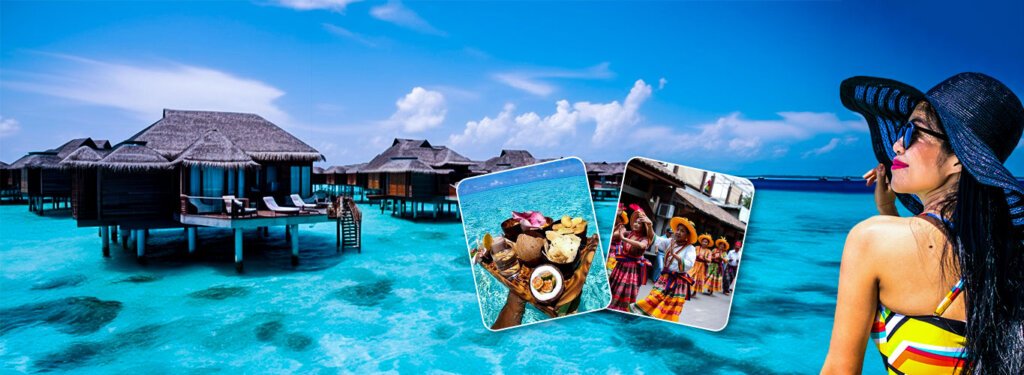
South India's No. 1 Travel Agency ✨
💱 Currency
Maldivian Rufiyaa (MVR)
🗣️ Languages
Dhivehi
🌤️ Climate
25°C – 31°C
📅 Best Season
November – April
🛡 Must-Know Travel Tips for Visiting Maldives
- 🏧 ATMs are available in Malé and larger local islands, but not on all resort islands — carry enough cash when island hopping.
- 💳 Credit cards are widely accepted at resorts and major guesthouses; local shops and ferries may require cash.
- 🏦 Banks operate Sunday to Thursday (closed Fridays); currency exchange is best done at the airport or in Malé.
- 🍷 Alcohol is only available at resorts and liveaboards — it's prohibited on local islands and in Malé.
- 🤝 Maldivians are warm and respectful; modest dress is appreciated on local islands, especially in public areas.
- 💰 Prices are higher during the peak season (Dec–Apr); for better deals, visit during the off-season (May–Oct).
What Is Maldives Famous For? – About Maldives Explained
The Maldives is world-renowned for its breathtaking natural beauty, luxurious overwater resorts, and crystal-clear turquoise waters. Many travelers are drawn to this island paradise through carefully curated Maldives tour packages that promise both relaxation and adventure.Comprising 26 coral atolls and over 1,000 islands, the Maldives attracts visitors from across the globe who seek pristine beaches, vibrant marine life, and a peaceful escape from urban life. The islands are surrounded by colorful coral reefs home to manta rays, sea turtles, and countless tropical fish, making it a top destination for snorkeling and scuba diving.Equally iconic are the overwater villas—private bungalows suspended above calm lagoons, offering direct ocean access and panoramic views of sunrise or sunset.The country also leads in eco-luxury tourism. Many resorts incorporate sustainability through coral conservation, solar energy, and eco-conscious design. The emphasis on environmental harmony adds depth to the experience.Beyond its natural appeal, the Maldives has a rich culture shaped by South Asian, Arab, and African influences. This is evident in local crafts, cuisine, music, and language. Whether you’re savoring fresh seafood under the stars or joining a sunset dolphin cruise, the Maldives offers an atmosphere of serenity and exclusivity that few destinations can match.
Maldives Tour Packages
Most Chosen Maldives Plans by Our Happy Customers
How Are India and Maldives Connected? – Cultural & Historical Ties
India and the Maldives share a deep-rooted connection that goes far beyond geography. Located just over 700 kilometers from India’s southern coast, the Maldives has long had historical, cultural, economic, and diplomatic ties with its larger neighbor.Historically, trade routes between the two regions have been active for centuries. Indian merchants and seafarers were among the first to exchange goods with the Maldives, trading rice, textiles, spices, and coconuts. The Dhivehi language contains Sanskrit and Tamil influences, and many traditional dishes in the Maldives include ingredients and spices commonly used in South India.Religion also shaped the relationship. Before Islam became the dominant religion in the 12th century, the Maldives practiced Buddhism, which came through contact with the Indian subcontinent. Several archaeological sites and artifacts from that era still show strong connections to Indian Buddhist traditions.Culturally, the two countries share similar customs in music, dance, and attire. Many Maldivians have familial or educational links to India, and Indian films, television shows, and music are extremely popular throughout the islands. Bollywood stars are frequently hosted by Maldivian resorts, and Indian festivals like Diwali and Eid are celebrated among communities.Modern relations between the two nations continue to grow through tourism, healthcare, education, and strategic cooperation. India has played a key role in supporting Maldives with infrastructure projects, emergency aid, and bilateral training programs. The easy connectivity via direct flights from Indian cities to Malé makes travel convenient and strengthens people-to-people ties.These historical and cultural threads weave a bond that is friendly, enduring, and deeply interlinked.
Interesting Things to Know About Maldives Before You Go
Before you pack your bags for the Maldives, there are a few fascinating and useful things you should know that will make your journey smoother and more enriching.Firstly, the Maldives is a Muslim-majority country, and while the private resort islands offer a relaxed and liberal atmosphere, Malé (the capital) and local islands follow more conservative customs. Modest clothing is recommended when visiting inhabited islands outside resort zones, and public displays of affection should be avoided in those areas. Each island is unique—some are just a few hundred meters long—so inter-island travel is done via speedboats, domestic flights, or seaplanes. If your resort requires a seaplane transfer, be prepared for limited operating hours during daylight only. The local currency is the Maldivian Rufiyaa, but US dollars are widely accepted in resorts and tourist areas. Tipping is appreciated but not mandatory, and many hotels include a service charge in the bill. English is widely spoken, especially in tourist hubs, so communication is rarely a problem.One of the most interesting aspects of Maldivian life is the adaptation to climate and geography. Most food is imported, but local dishes often feature freshly caught tuna, coconut, and rice. The country is also at the forefront of climate change awareness due to its low elevation, with several environmental initiatives in place to protect coral reefs and promote sustainable tourism. The Maldives is not just for luxury travelers—many local islands now offer affordable guesthouses and boutique stays, allowing visitors to experience authentic Maldivian culture at a lower cost. These islands give you access to community life, traditional fishing trips, local crafts, and home-cooked meals. Lastly, the Maldives is one of the few places in the world where you can experience natural bioluminescence—tiny organisms in the water emit a blue glow at night, turning the sea into a magical light show, especially around islands like Vaadhoo. From travel logistics to hidden natural wonders, understanding the Maldives before your visit will ensure your trip is smooth, respectful, and unforgettable.
What to Know Before Booking a Maldives Tour Package
Before booking a tour package to the Maldives, it’s important to understand what type of travel experience the destination offers. The Maldives is renowned for its white-sand beaches, turquoise lagoons, and luxurious overwater villas, but the country also has a range of experiences suited to various travel preferences and budgets. One of the first decisions to make is whether to stay on a private island resort or a local island. Private island resorts offer seclusion, all-inclusive luxury, and exclusive amenities like private pools, underwater restaurants, and spa treatments. However, local islands like Maafushi or Thulusdhoo offer more budget-friendly guesthouses and authentic Maldivian culture.Another key factor is understanding how transportation works. Many resorts require speedboat transfers or seaplane rides from Malé International Airport, which can add a significant cost to the trip. It’s essential to check whether your tour package includes these transfers. Weather also plays a role in planning; the Maldives has a tropical climate with a dry season from November to April, considered the peak tourist season. The wet season runs from May to October, which may bring occasional rain but also lower prices and fewer crowds.Tour packages can range from romantic honeymoon getaways and family vacations to diving or surfing trips. Consider what activities are included—snorkeling, dolphin cruises, island hopping, or spa treatments—and ensure the package aligns with your interests. All-inclusive options may seem expensive at first glance but often provide better value once food, beverages, and excursions are factored in. It’s also wise to review the resort’s house reef quality if you’re a snorkeler or diver, as some islands offer rich marine life right off the beach. Booking a Maldives tour requires balancing dreams of tropical luxury with practical details like location, transfers, inclusions, and weather for the most memorable and stress-free experience.
Which Are the Best Budget Maldives Tour Packages?
Traveling to the Maldives on a budget is entirely possible and increasingly popular, especially with the growth of local island tourism and guesthouse accommodation. While the destination is often associated with luxury resorts and celebrity honeymoons, there are affordable tour packages that let travelers experience the same stunning landscapes, clear waters, and vibrant marine life without overspending. Many budget packages focus on stays in local islands such as Maafushi, Dhigurah, or Thoddoo, where guesthouses offer comfortable lodging, home-cooked meals, and guided excursions at a fraction of the cost of private island resorts.These budget packages often include essentials such as airport transfers by public ferry or speedboat, daily breakfast, basic excursions like sandbank visits or snorkeling trips, and occasionally activities such as night fishing or dolphin cruises. Travelers on a tighter budget can save even more by eating at local cafés, joining group tours rather than private ones, and avoiding expensive extras like alcohol or spa treatments, which tend to be more common in private resorts.A well-designed Maldives tour plan typically spans 4 to 6 days and balances relaxation with experiences. Days can be spent exploring coral reefs, relaxing on bikini beaches (where permitted), and interacting with the friendly Maldivian locals. Island hopping tours allow you to visit nearby inhabited and uninhabited islands without the high price tag of resort-hopping. Many guesthouses now offer packages tailored to budget-conscious couples, solo travelers, or small groups, making the Maldives accessible without compromising the beauty and tranquility it’s famous for.With proper planning and realistic expectations, a budget Maldives tour can be just as dreamy and immersive as a luxury escape.
Quick Facts About Maldives – Geography, Wildlife & People
The Maldives is an island nation in the Indian Ocean, composed of 26 natural atolls and over 1,000 individual islands, of which around 200 are inhabited. Spread over 90,000 square kilometers of ocean, the country is one of the most geographically dispersed in the world. Its capital city, Malé, is densely populated and serves as the political, economic, and cultural hub. The islands are mostly flat and barely rise above sea level, making the Maldives particularly vulnerable to climate change and rising sea levels.Geographically, the Maldives is famous for its turquoise waters, coral reefs, and soft white-sand beaches. The surrounding waters are home to some of the richest marine biodiversity in the world. Coral reefs, lagoons, and reef walls make it a paradise for snorkelers and scuba divers. In terms of wildlife on land, the Maldives has fewer terrestrial animals due to its isolated island geography. However, various seabirds, fruit bats, and geckos are common sights. The islands are also known for their lush coconut palms and tropical vegetation that thrive in the salty, humid environment. The real biodiversity treasure lies beneath the sea, with more than 2,000 species of marine life inhabiting the reefs and lagoons.
The people of the Maldives are known as Maldivians and are predominantly Sunni Muslims. The culture is a blend of South Indian, Arab, and East African influences, reflected in the language, cuisine, music, and daily life. Dhivehi is the official language, and English is widely spoken, especially in tourist areas. Traditional life revolves around fishing, boat building, and community celebrations, while modern life increasingly caters to tourism. Maldivian hospitality is warm and welcoming, with visitors often invited to experience local traditions, foods, and crafts. Though small in size, the Maldives offers a rich natural and cultural identity that continues to enchant travelers from around the world.
Maldives Tour Packages
| High Season | November to April (Dry Season / Peak Tourist Months) |
|---|---|
| Iconic Attractions | Malé City, Maafushi Island, Hulhumalé Beach, Hanifaru Bay, Vaadhoo Island |
| Popular Activities | Snorkeling, Scuba Diving, Dolphin Cruises, Overwater Stays, Island Hopping, Sandbank Picnics |
| Visa | Visa-free for 30 days on arrival for most countries (including Indian passport holders) |
| National Animal | Yellowfin Tuna |
| National Flower | Pink Rose |
| Famous Food | Mas Huni, Garudhiya, Fihunu Mas, Rihaakuru, Bajiya, Coconut-based Curries |
Top Reasons Why Tourists Love Visiting Maldives
The Maldives captivates the hearts of travelers with its unmatched natural beauty and the promise of serenity at every turn. From the moment tourists arrive, they are met with views of turquoise lagoons, overwater villas, and pristine white sands that define paradise.One of the most enchanting reasons tourists fall in love with the Maldives is its overwater resorts. These iconic accommodations offer ultimate privacy and direct access to the lagoon, allowing guests to wake up to ocean views, dip into the sea from their deck, and fall asleep to the sound of gentle waves. Whether it’s for a honeymoon, anniversary, or solo retreat, the overwater villa experience is unforgettable.Marine life in the Maldives is another major draw. Snorkelers and scuba divers are rewarded with thriving coral reefs, manta rays, whale sharks, sea turtles, and thousands of tropical fish species. The clear waters offer exceptional visibility, and resorts often have house reefs just meters from the shore, making underwater exploration easy and mesmerizing.Romantic escapes are perfectly tailored in the Maldives. Sunset cruises, candlelit beach dinners, private sandbank picnics, and stargazing from a hammock are just some of the intimate experiences that create lasting memories for couples. The setting naturally evokes love and tranquility, which is why the Maldives is a favorite among honeymooners.The sense of exclusivity is something that sets the Maldives apart. Each resort is typically located on its own island, which means visitors enjoy unparalleled seclusion, peace, and personalized service. The absence of crowds enhances the feeling of being on a private, untouched island far away from the hustle of everyday life.Many Maldives tour packages today include opportunities to engage with these cultural experiences, whether through visits to local islands, traditional cooking classes, craft demonstrations, or cultural shows—offering a richer and more meaningful perspective of the Maldives beyond its postcard-perfect beaches. Spa and wellness are an essential part of the Maldivian experience. Many resorts offer overwater or jungle spa treatments using natural, locally sourced ingredients.Sunrise yoga, holistic detox programs, and time-honored healing practices are deeply woven into the Maldivian wellness experience. The local cuisine reflects a rich fusion of South Asian, Arabic, and tropical island flavors.. Guests enjoy a fusion of grilled seafood, coconut-based curries, tropical fruits, and exotic desserts. Some resorts even offer underwater dining, floating breakfasts, or chef-curated tasting menus for a culinary adventure as luxurious as the setting.Water sports and island adventures keep thrill-seekers engaged. From parasailing and jet-skiing to kayaking, surfing, and diving, there’s no shortage of high-adrenaline activities. Guests can also go island hopping, visit local fishing villages, or take seaplane tours for a bird’s-eye view of the atolls.Cultural experiences offer insight into Maldivian life beyond luxury. Local islands provide opportunities to witness traditional crafts, hear Boduberu drumming, or enjoy a meal with a Maldivian family. These interactions add depth and connection to the travel experience.
The natural environment is breathtaking in its simplicity and purity. Sunsets paint the sky with fiery colors. Bioluminescent plankton make the ocean sparkle at night. The absence of high-rise buildings and traffic means guests reconnect with nature in its raw, untouched form.The staff at resorts, boat operators, chefs, and local hosts are known for their kindness, respect, and attention to detail. This genuine care makes travelers feel not just welcome, but truly valued.
When Is the Best Time to Visit Maldives for Travel?
The Maldives is a year-round tropical destination, but the best time to visit largely depends on your travel priorities—be it relaxing beach holidays, marine safaris, or water sports. Generally, the dry season from November to April is considered the best time for travel. During these months, the skies are clear, humidity is lower, and the seas are calm, making it perfect for sunbathing, snorkeling, scuba diving, and boat excursions. This is also the peak season, especially around December and January, so resorts are in high demand and prices tend to be higher.For those interested in marine life safaris—such as diving with manta rays or whale sharks—the best time is between December and May when visibility is at its peak and the plankton blooms draw in large marine animals. The famous Hanifaru Bay in Baa Atoll, a UNESCO Biosphere Reserve, is known for spectacular manta ray gatherings between May and November, offering an unforgettable safari-like underwater experience.While this period sees fewer tourists and lower prices, it still offers plenty of sunny spells and is ideal for travelers looking to enjoy the Maldives on a budget. Surfers also prefer this time for consistent waves, particularly in North and South Male Atolls.Whether you’re lounging by the beach, exploring coral reefs, or cruising through the atolls on a traditional dhoni boat, the Maldives has a season for every type of traveler. With its warm temperatures throughout the year, there’s truly no bad time to visit—just different experiences waiting to unfold.
What Are the Best Things to Do in Maldives?
The Maldives is a haven for relaxation and adventure, offering a wide variety of activities that cater to both the luxury seeker and the nature enthusiast. One of the most iconic experiences is staying in an overwater villa, where you can wake up to panoramic ocean views and take a dip directly into a crystal-clear lagoon. Many visitors come solely for this once-in-a-lifetime kind of stay.Snorkeling and scuba diving are top highlights, thanks to the Maldives’ rich marine biodiversity. Resorts often have their own house reefs, and excursions take you to dive spots where you can swim alongside manta rays, reef sharks, sea turtles, and vibrant coral gardens.
Sunset cruises on traditional wooden dhonis offer a peaceful way to enjoy the ocean, often paired with dolphin watching and refreshments. Island hopping tours give travelers a glimpse of daily life on local islands, where you can shop for crafts, meet Maldivian families, and explore ancient coral mosques. In the surfing season, the Maldives offers some excellent breaks, especially in areas like Thulusdhoo and Himmafushi.For those looking to unwind, the Maldives is a spa paradise. Overwater and beachfront spas offer massages, wellness treatments, and yoga sessions using natural, ocean-inspired ingredients. Some resorts also host underwater dining experiences, private sandbank picnics, or movie nights beneath the stars.
Nighttime in the Maldives can be magical too—certain beaches are known for bioluminescent plankton that light up the shoreline, creating glowing blue waves underfoot. Whether you’re looking to reconnect with nature, indulge in luxury, or explore island life, the Maldives delivers experiences that are as tranquil or as adventurous as you want them to be..
What Food Is Maldives Known For? – A Guide to Maldives Cuisine
Maldivian cuisine, known as Dhivehi cuisine, is a delicious blend of South Indian, Sri Lankan, and Arabic influences, shaped by the archipelago’s oceanic surroundings and tropical produce. Seafood, coconut, and rice form the foundation of most dishes, with tuna being the undisputed star of the Maldivian kitchen.One of the most iconic dishes is Mas Huni, a traditional Maldivian breakfast made from shredded smoked tuna, coconut, onion, and chili, typically served with roshi (flatbread) and a hot cup of sweetened tea. It’s a simple, hearty way to start the day and gives travelers an authentic taste of local flavors.Another staple is Garudhiya, a clear fish broth served with lime, rice, chilies, and onions. It’s light, fragrant, and comforting, often consumed by locals for both lunch and dinner. Fihunu mas, or grilled fish marinated in a blend of chili, lime, and spices, is popular at beachside cafés and resort restaurants.Coconut is used in various forms—grated, milk, and oil—and adds depth to both savory and sweet dishes. Rihaakuru, a thick, brown fish paste, is used as a condiment or flavor base in many traditional meals. Curries made with tuna, chicken, or vegetables are common and usually served with rice or roshi.Sweet lovers will enjoy bondibai, a sweet sticky rice dish flavored with coconut milk, cardamom, and rose water.Although international cuisine is widely available in resorts, trying Maldivian dishes offers a window into the country’s soul. Many resorts now host Maldivian nights, showcasing local music, dance, and an elaborate buffet of traditional fare. For a deeper dive into island flavors, travelers can also dine at guesthouses on local islands or enjoy home-cooked meals arranged by local hosts.Maldivian cuisine may not be globally famous, but it surprises and delights visitors with its freshness, simplicity, and richness in flavor—a perfect companion to the natural beauty that surrounds it.
Maldives Tour Packages
| Dhigurah Island | Whale shark spotting, long sandy beach, local culture, budget stays |
|---|---|
| Addu Atoll | Scenic cycling trails, WWII sites, British architecture, untouched lagoons |
| Ari Atoll | Whale shark diving, luxury resorts, underwater restaurants, coral gardens |
| Vaadhoo Island | Famous for glowing bioluminescent beaches, peaceful island atmosphere |
| Baa Atoll (Hanifaru Bay) | UNESCO Biosphere Reserve, manta ray snorkeling, rich coral reefs |
| Hulhumalé | Urban beach island, artificial beach, cafés, sunset views, transit hotels |
| Maafushi | Budget guesthouses, water sports, bikini beach, snorkeling tours, local cafés |
What Should Indian Travellers Know Before Visiting Maldives?
For Indian travelers, the Maldives offers an inviting blend of exotic scenery, easy accessibility, and cultural comfort. But before you take off to this island paradise, there are a few practical things you should know to make the most of your trip.Firstly, visa is not a concern—Indians receive a free visa-on-arrival for 30 days, making travel paperwork simple and stress-free. Though the Maldives is a Muslim-majority nation, it warmly welcomes international tourists. Still, modest dressing is advised when visiting the capital Malé or any inhabited local island. Bikinis and swimwear are acceptable on private resorts and designated “bikini beaches” on local islands. Public displays of affection should be avoided in non-resort areas as a sign of cultural respect.Currency-wise, the Maldivian Rufiyaa (MVR) is the official currency, but US dollars are widely accepted in resorts and tourist shops. Credit cards work almost everywhere in private resorts, but it’s wise to carry some cash when visiting local islands or using public ferries. Tipping is not mandatory but always appreciated.Food may feel familiar to Indian palates.While vegetarian options can be limited on some islands, resorts and guesthouses usually cater to dietary preferences when requested in advance.
Mobile connectivity is good, especially with a local SIM card from Dhiraagu or Ooredoo, available at the airport. Wi-Fi is usually free at resorts and guesthouses. Safety is not a concern in most parts of the country, making it suitable for couples, families, and solo Indian travelers.Lastly, while alcohol is freely available in resorts, it’s prohibited in Malé and on local islands. If you’re staying at a local guesthouse, be aware of this restriction and plan accordingly.
Where to Shop in Maldives – Best Markets & Souvenirs
Shopping in the Maldives isn’t about big malls or luxury boutiques—instead, it’s a chance to explore local artistry, island-made goods, and cultural keepsakes. While most travelers come here for the scenery and relaxation, taking home a few handpicked souvenirs is a great way to remember the trip.The best place to shop is Malé, the capital city, where traditional markets, souvenir shops, and local boutiques are all within walking distance. Majeedhee Magu, the main shopping street, is lined with shops selling local textiles, handcrafted jewelry, sarongs, and beachwear. It’s a good place to pick up reasonably priced items and get a feel for local life.Local markets, such as the Malé Local Market near the waterfront, offer spices, pickled fruits, coconut oil, and dried seafood—perfect for those who want to bring a taste of the Maldives back home. For handcrafted souvenirs, Chaandhanee Magu is the go-to street. Here, you’ll find lacquered wooden boxes, handmade coir rope mats, miniature dhoni boats, and coral or shell jewelry (though ensure items aren’t made from endangered materials).In the local islands where guesthouses are common—like Maafushi or Thoddoo—small souvenir stores often sell locally made goods, hand-painted t-shirts, fridge magnets, or woven crafts. These purchases support local businesses and are often more affordable than resort shops.Shopping at resort islands is also possible, though prices tend to be higher. Resorts typically have boutique stores offering spa products, designer beachwear, and polished souvenir items, ideal for last-minute gifts.While bargaining isn’t a strong tradition in Maldivian culture, you can sometimes negotiate gently, especially in local markets. Also, note that coral and turtle shell products are illegal to export and should be avoided both for legal and environmental reasons.
How Is the Art and Culture Scene in Maldives?
The Maldives may be better known for its beaches than its museums, but its art and culture scene is deeply rooted in its seafaring heritage, Islamic traditions, and centuries of cultural exchange through Indian Ocean trade routes. For travelers willing to look beyond the surface of luxury resorts, the islands reveal a rich cultural identity shaped by African, Arab, South Asian, and Southeast Asian influences.Traditional Maldivian culture is vibrant and community-driven, with oral storytelling, music, craftsmanship, and ritual customs forming the backbone of island life. One of the most admired traditional arts is lacquer work (Liye laajehun)—a meticulous craft involving the decoration of wooden items with vibrant layers of red, black, and yellow. These handmade pieces, including containers and trays, are produced in specific islands and are often sold as authentic souvenirs.It’s typically performed during celebrations and festivals, and visitors may be lucky enough to experience a performance in Malé or on cultural evenings arranged by guesthouses or resorts.Religious architecture also plays a significant role in Maldivian cultural expression. Historical mosques like the Hukuru Miskiy (Friday Mosque) in Malé showcase coral-stone carvings, finely crafted wooden panels, and Islamic calligraphy, reflecting the aesthetic and spiritual values of the countryWhile traditional forms remain important, contemporary art is emerging, particularly in urban centers like Malé. A new wave of Maldivian artists is exploring themes of environmental change, identity, and daily life through painting, photography, street murals, and digital installations. Occasional art exhibitions and cultural festivals in the capital offer visitors a glimpse into this evolving creative scene. The Maldives also celebrates several national and religious festivals throughout the year, including Independence Day, National Day, and Eid celebrations. These events often feature parades, traditional costumes, community feasts, and public performances that reveal the strong social fabric of island life.make the most of these diverse experiences, a thoughtfully designed Maldives tour plan ensures you don’t miss out on the best the islands have to offer, from luxury and nature to culture and adventure.















